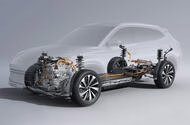BYD is gearing up to shake up the plug-in hybrid market with an exciting new lineup that promises impressive electric-only ranges and rapid charging capabilities. Imagine driving a hybrid that can go up to 124 miles on electricity alone—sounds like a game changer, right? This is exactly what BYD aims to deliver with its forthcoming DM-i series of plug-in hybrids, set to hit the market within the next couple of years.
### What Makes BYD’s New PHEVs Stand Out?
Currently, the longest electric range for a plug-in hybrid electric vehicle (PHEV) in the UK is 88 miles, courtesy of the Volkswagen Golf eHybrid. BYD’s existing model, the Seal U, offers a respectable 77 miles but can only charge at 18kW. The new DM-i models, however, are set to leapfrog these figures with a remarkable 200 km (124 miles) of electric-only range and the ability to charge at speeds exceeding 150kW. This leap in technology could redefine what consumers expect from PHEVs.
Stella Li, BYD’s executive vice-president, emphasizes that the goal is to encourage daily use of the EV mode while still providing the flexibility for longer trips. This dual approach caters to both everyday commuters and those who occasionally need to travel further without the anxiety of running out of battery.
### The Technology Behind the DM-i System
At the heart of BYD’s innovation is the DM-i system, which integrates their advanced Blade Battery technology with a specially designed petrol engine. This engine boasts world-leading thermal efficiency, making it a formidable player in the hybrid arena. The combination allows for a seamless transition between electric and petrol power, ensuring that drivers can maximize efficiency based on their needs.
Alfredo Altavilla, BYD’s special advisor for Europe, notes that the PHEV market is becoming increasingly competitive. As manufacturers aim to refine their green technologies, BYD believes it has a significant edge with its DM-i system. Altavilla argues that many existing PHEVs fall short, offering only 22-28 miles of electric range, which he likens to merely being a petrol car with a plug.
### The Rise of Range-Extender Vehicles
Interestingly, BYD isn’t the only player in this evolving landscape. Companies like Ford, Leapmotor, and Lotus are exploring range-extender (REx) vehicles, which utilize a small petrol engine to generate electricity for an electric motor. Leapmotor’s overseas boss recently described REx cars as a “good interim solution” for Europe, highlighting their efficiency. However, Altavilla counters that traditional PHEVs offer more versatility, allowing drivers to choose how they want to use their vehicle.
### What’s Next for BYD in the UK?
As the UK prepares to welcome the Seal 06 saloon and estate models, BYD is positioning itself as a serious contender in the PHEV market. With the promise of longer electric ranges and faster charging, these new models could attract a wide range of consumers looking for greener alternatives without sacrificing convenience.
### Final Thoughts
The big takeaway? BYD’s upcoming PHEVs aren’t just about extending electric range; they represent a shift in how we think about hybrid technology. As manufacturers refine their offerings, consumers will benefit from more choices that align with their lifestyles. If you’re in the market for a hybrid, keep an eye on BYD’s innovations. They might just redefine what you expect from a plug-in hybrid.

